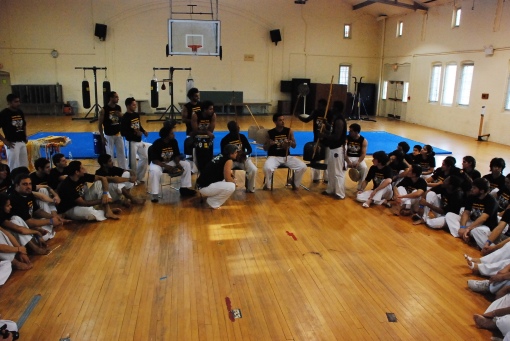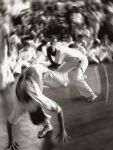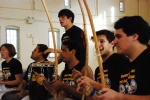Capoeira, put simply, is a martial art developed during the 1700’s in Brazil by slaves brought to the Americas. It focuses on rhythm, spontaneity and flowing movements that practitioners of capoeira, called capoeiristas, perform while practicing capoeira.
Many people mistake capoeira for a dance, or assume that the movements done when two capoeiristas go up against each other are choreographed. This is not the case. Anderson Da Silva, a capoeirista since he was 3, said that the reason why capoeira looks so similar to a dance is so one can mislead an opponent.
The purpose of capoeira isn’t to hit and defeat your opponent through physical contact, but rather maneuvering them into a position where you can trick or trap them. This is done in what’s called a roda, a Portuguese word meaning wheel. It’s pronounced ho-da, as r’s in Portuguese are pronounced like h’s.

A roda de capoeira at Capoeira Balance's batizado.
The roda is a circle of capoeiristas with several playing instruments at one end of the circle. They play the instruments, clap and sing as those inside the ‘play’ capoeira.
This is what I think makes capoeira the most unique martial art of all the ones I’ve seen, heard about, or experienced. Capoeira is referred to as a game. Capoeiristas play the game of capoeira when they are ‘fighting’ someone else. This is called jôgo de capoeira, or playing capoeira. Bira Almeida, a capoeira mestre (master), said in his book about capoeira, Capoeira: A Brazilian Art Form, that “the jogo is the essence of capoeira and must be considered its most valid expression because only through it can students truly develop and express their authentic capoeirista nature.” Capeoira can be practiced and developed, but it is only by playing with another person in a roda does one actually play capoeira.
The goal when playing against someone in a roda isn’t to beat them up, but to express oneself with their body. Kicking, dodging or simply moving around, it’s all done with someone to create a game in which two people express themselves with their movements and create a conversation with their bodies.
“The first rule of my school is that if you get hit, it is your fault,” Almeida says in his book. “The second is, if you hit unintentionally, it is also your fault.” While contact will inevitably happen in capoeira, again it is not the focus of playing and should be taken in stride.
Capoeira as a whole is a complex, intricate martial art. But, as the UConn capoeira club often advertises, it’s fun, culturally engaging and one heck of a good workout.



Leave a comment